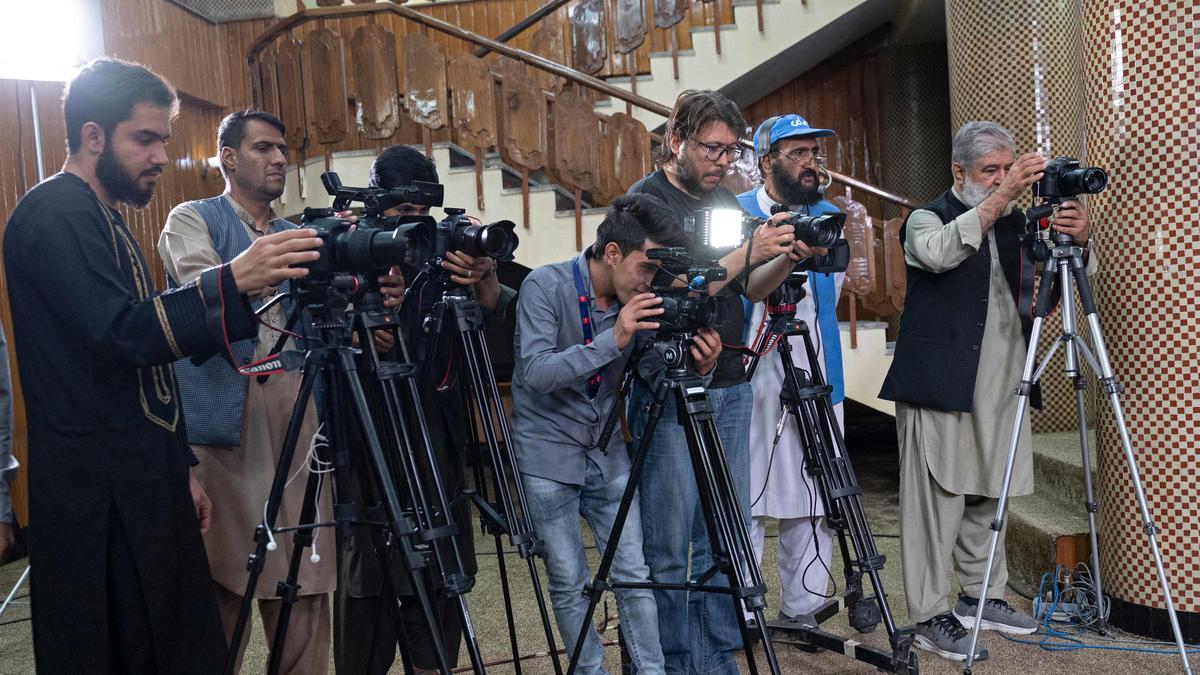
Afghan journalists attend a press conference by Afghan Foreign Minister Amir Khan Muttaki in Kabul on September 19, 2024. Afghanistan’s Taliban Ethics Ministry on October 14 promised to enforce a law banning news media from publishing images of all living things, along with journalists. Told that the rule will be implemented gradually. , Photo courtesy: AFP
Afghanistan’s Taliban ethics ministry on Monday (October 14, 2024) promised to enforce a law banning news media from publishing images of all living things, with journalists telling reporters the rule would be gradually enforced.
This comes after the Taliban government recently announced legislation formalizing their strict interpretations of Islamic law, which have been implemented since they came to power in 2021.

“This law applies to the whole of Afghanistan… and will be implemented gradually,” said Saiful Islam Khaibar, a spokesman for the Ministry of Propagation of Virtue and Prevention of Vice (PVPV). AFPSaying that officials would work to make people understand that images of living things are against Islamic law.
“There is no place for coercion in law enforcement,” he said.
“This is just advice, and to make people understand that these things are actually contrary to Sharia (law) and should be avoided.”
The new law details a number of rules for news media, including banning the publication of images of all living things and ordering outlets not to ridicule or insult Islam or contradict Islamic law.
Aspects of the new law have not yet been strictly enforced, including advice to the general public not to take or view photos of living things on phones and other devices.
Taliban officials regularly post photos of people on social media and Afghan journalists told AFP that after the law was announced they had received assurances from authorities that they would be able to continue their work.

The Information Ministry did not immediately respond. AFPRequest for comment.
“With regard to the articles of the law related to media, efforts are still underway in many provinces to implement it, but it has not started in all provinces,” Khyber said.
He said “work has begun” in the southern Taliban stronghold of Kandahar and neighboring Helmand province, as well as northern Takhar.
Before the recent law was announced, Taliban officials in Kandahar were banned from taking photographs and videos of living things, but the rule did not include news media.
“Now it applies to everyone,” Khyber said.

Journalists were called
On Sunday (October 13, 2024), PVPV officials in central Ghazni province called local journalists and told them that morality police would gradually begin enforcing the law.
He advised on-the-scene journalists to take photographs from a distance and film fewer events “to get used to it”, a journalist who did not want to be named for fear of retribution told AFP.
In a similar meeting, journalists from Maidan Wardak province were also told that the rules would be implemented gradually.
Television and photographs of living things were banned across the country under the previous Taliban regime from 1996 to 2001, but a similar order has not been widely enforced since their return to power.
However, since 2021, authorities have sporadically forced business owners to follow certain censorship rules, such as crossing out men’s and women’s faces on advertisements, covering the heads of shop mannequins with plastic bags , and staining the eyes of the fish depicted on restaurant menus. ,
When Taliban authorities took control of the country after a two-decade-long insurgency against foreign-backed governments, there were 8,400 media workers in Afghanistan.
According to media industry sources, only 5,100 are left in the profession.
The figure includes 560 women who have borne the brunt of what the United Nations calls “gender apartheid” restrictions, including mandates to wear masks on television.
Women’s voices are banned on television and radio in Helmand.
Afghanistan has slipped from 122nd place to 178th out of 180 countries in the press freedom rankings compiled by Reporters Without Borders (RSF).
published – October 14, 2024 10:41 PM IST
